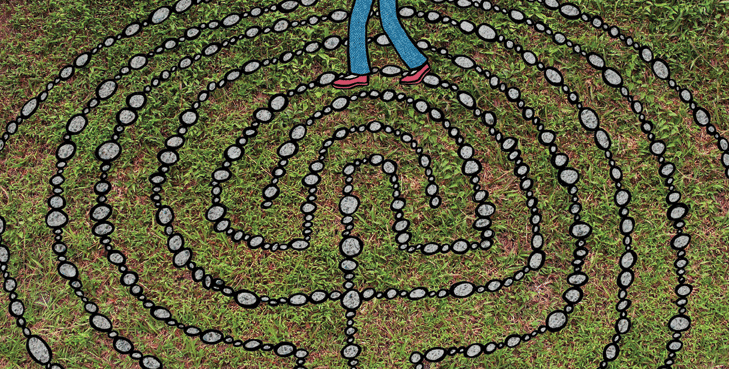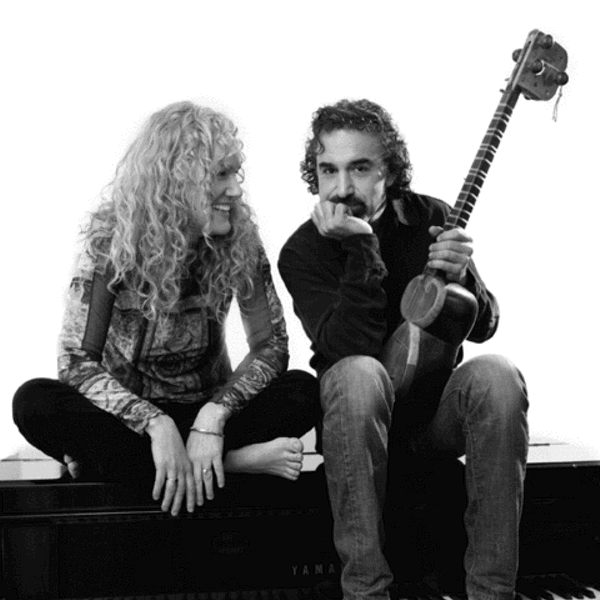Space for Healing
An Architect and an Academic Tap Into the Therapeutic Power of Place
[]
Mama, let’s go see the big Buddha.” This sudden proposal from my three-year-old daughter comes amid a day of surprises, most of them unwelcome and leaving me rough around the edges. Is this just another example of her carefree, preschool whimsy asserting itself? Or is she, from a subtle, wise-child knowing, offering a salve for mama’s out-of-sorts mood? In any case I obey my tiny spiritual guide, and we head off in the car for a visit to the main shrine room at Karma Triyana Dharmachakra monastery in Woodstock. Slipping off our shoes, we enter an incense-perfumed refuge. Warm, bright colors surround us, lit by dozens of prayer lanterns and the gold-leaf glow of a giant Buddha statue. Usually a whirling dervish of energy, my daughter settles quietly into my lap amid the meditation cushions. There is a shift in me, too, as a gray veil lifts from my consciousness and leaves a light contentedness in its place.
Whether they’re monasteries or malls, nature preserves or boardrooms, the spaces we inhabit affect us. We don’t need science to prove this—personal experience will do just fine—but science has gone ahead and made the fact official, as it likes to do. More than that, science has shown that spaces can affect us in more dramatic ways than most of us even realize. Take the oft-cited 1984 medical study that compared the records of 46 patients recovering from gallbladder surgery; half of the patients were assigned to rooms with a window view of a natural setting, while the other 23 subjects inhabited similar rooms with windows facing a brick wall. The difference was impressive, as the room-with-a-view patients averaged a 25 percent shorter postoperative hospital stay, received fewer negative evaluative comments in nurses’ notes, and requested fewer potent analgesics than the brick-wall-view patients. Similar studies followed, and designers started to take notice.
“A relationship exists between environment and health outcome,” says Francis Pitts, an architect specializing in hospital design and a principal at Architecture+, based in Troy. Back in the `90s, Pitts was something of a pioneer in what he calls therapeutic spaces. “At that time, when we began using terms like ‘healing environment’ and ‘patient-centered environment,’ we were received with skepticism. People talked about it as a California fad, like we had eaten too much granola. Today, it’s impossible to read the literature and not hear about these ideas. Now they’re just naturally employed. The last 10 years have been an extraordinarily interesting time in hospital design.”
Sacred Places, Healing Spaces
It seems that certain environmental cues can help turn on our body’s relaxation response, reducing unhealthy stress and restoring a sense of wholeness and peace. Herbert Benson, a cardiologist, famously described this response in the 1970s as an activation of the parasympathetic nervous system, which causes the body to relax and can bring profound health effects, such as a strengthened immune system. What makes certain spaces more healing than others? I take this question with me on a journey down the Thruway to SUNY New Paltz, where Dr. Lyla Yastion, adjunct professor of anthropology, is introducing her two-week summer course, “Sacred Spaces.” The computer-projected image of a Native American medicine wheel looms overhead as Yastion, author of Pause Now: Handbook for a Spiritual Revolution (Hamilton Books, 2009), launches into a discussion of the geometry of sacred symbols and soulful places. Folding in Celtic crosses, indigenous spirituality, Buddhism, Ralph Waldo Emerson and the Transcendentalists, and St. John the Divine cathedral in Manhattan, Yastion argues convincingly that there is some consensus across cultures and traditions on what constitutes sacred space. Could there be a universal truth about such places—and if so, what is it? Do we assign sacredness to a place, or are some spaces inherently infused with supernatural energies?
While such lofty academic questions swirl, I begin to wonder if there is really a connection between “sacred” and “healing”—two contemporary buzzwords bordering on the overuse that can strip charged words of their meaning. Then Yastion steps in with an explanation that sufficiently bridges the gap between them. “The words health, healing, whole, and holy all have the same Anglo-Saxon root, hal, which means whole or healthy,” she says. Sacredness and health literally grow from the same seed. Yastion mentions examples of sites that the class will visit on field trips—a nature preserve, monastery, cathedral, and ashram—each offering its own kind of restorative medicine. “Places like these give us solace and realign the body-mind-heart-spirit into an integrated whole. We feel their effects as health and happiness.” Turning again to etymology, Yastion points out that an ordinary place, called topos in Greek, can be transformed—whether through history, personal experience, or some other energizing force—into choros, a sacred place. With intention and attention, we can sacrilize—or at least optimize—the spaces around us and make them more healing. The question remains, but how?
A New Kind of Hospital
Hospitals are topos through and through—they are ideologically neutral, secular places—and they need to be. Hosting people from diverse cultural backgrounds, hospitals can’t risk alienating health-care consumers with something as subjective as spirituality. Science is the only god admitted here. But according to architects like Pitts (who would never use a New Age catchphrase like “body-mind-heart-spirit”), that doesn’t mean we have to accept less than optimal surroundings. “The traditional model for the design of a hospital revolves around the delivery of services,” he says. “It’s doctor- and nurse-centric.” The downsides of that model are obvious to anyone who has ever been in a hospital and felt assaulted by round-the-clock noise, bright lights, pungent odors, and a jarring lack of privacy. The new wave of hospital design says good riddance to as much of that as possible. “A complementary point of view to the traditional model suggests that there’s a difference between healing and curing,” he adds. “Curing is about providing a procedure or administering a drug—it’s an intervention that’s often necessary. Healing is what comes afterwards, and it’s what the body does naturally. Hospitals designed around the delivery of services focus on the optimization of the curing process, but they don’t really address the needs of the healing process. We’re coming to the conclusion that it is important to create an environment that focuses as much on healing as it does on curing, supporting the body’s natural tendency to heal and reducing the amount of stress that we create in hospitals traditionally.”
Transforming a hospital into a healing environment involves bringing certain elements into play. A focus on nature is primary, says Pitts, who incorporates natural views and natural materials in his designs. Positive distractions from boredom, sameness, and pain can take the form of water sounds or music, or the aromas of good food, while acoustic or soundproofing elements can buffer patients from the bustle of 24/7 nursing activity. Lighting that doesn’t interfere with the sleep-wake cycle can promote healing, as can a space that allows quality interaction with visitors and not just edge-of-the-bed perching amid hospital equipment. Several studies have confirmed that a private environment is essential to accelerating the healing process; happily, shared rooms are becoming passé in hospitals thanks to new guidelines from the Center for Medicaid and Medicare. “If you are building a new hospital, it has to have all private rooms,” says Pitts. For future patients, things are looking up; hospitals are getting almost warm and fuzzy.
Paths to Wholeness
On my next visit to Yastion’s seminar, nature is our classroom, and the sounds of raindrops and mourning doves fill the pauses around the professor’s words. “Sacred space is more than a concept; it’s an experience,” she says. “We can find it in a mountaintop, a river, a forest clearing. In our modern world of buildings and roads, we can be starved for this kind of nourishment.” We have come to the Mohonk Preserve to visit a replica of a Native American medicine wheel and to, as the Lakota Sioux describe it, walk in a sacred manner with nature. “Are we losing our connection to the land, to our geography? The flux of people to national parks is down,” says Yastion. “We have to use our intelligence to shift from an egocentric world view to an ecocentric one—in which we recognize sacred land and respect our place in the great web of life.”
It’s here on the rain-soaked trails that Yastion introduces a practical way of bringing sacred space into our everyday lives. After a morning dedicated to Native American and Buddhist philosophies, Yastion segues into an introduction to walking meditation. We are instructed to walk a length of trail with quiet focus and attention, to be present for each footfall. As my motorcycle boots press against the wet earth I think of lotus flowers blossoming underfoot, as the Buddha was said to have left with each footprint. According to the Vietnamese Buddhist monk Thich Nhat Hanh, we are to feel peace with every step; we can find solace from our worries by simply being awake to the miracle of our bodies stepping upon the miracle of the Earth. “Any time we move in space in a conscious manner, we are manifesting and creating sacred space,” says Yastion. She sends us home with an assignment: We are to practice this same meditative mindfulness while engaged in one ordinary activity, such as getting dressed or washing dishes. We don’t need to visit a monastery or even be in nature; we can make sacred space wherever we go.
Beauty Without, Beauty Within
In his business of dealing with literal-minded, results-oriented administrators and doctors, it’s unlikely that you’ll ever hear Pitts quoting someone like Thich Nhat Hanh. (“I’m not going there entirely,” he says when our conversation borders on the spiritual. “I need to be effective talking to people who don’t necessarily embrace that belief system.”) Yet I can’t help but notice a few striking similarities to his hospital work and the kind of work in the world that Yastion is asking us to do. At one of the crown jewels in his firm’s portfolio—the brand-new, therapeutically designed Worcester Psychiatric Hospital in Massachusetts—he included plans for four labyrinths in the courtyard. Visually beautiful, these ancient geometric tools invite the quiet contemplation of walking meditation. “They’re an effective way to allow someone to move and focus, and to find comfort in that process,” says Pitts, who carefully keeps his language free of mysticism.
Perhaps we respond to healing places because they actively remove stress and let the body do what it does naturally: restore itself to wholeness. Or, taking the mystic view, places like these reflect back to us our own essential nature—an inner landscape of peace that is always available to us. “When we are attentive we discover that the outer is the inner, and the inner is the outer,” says Yastion. “We resonate with these places because the sacredness we see without we feel within our hearts. It is the same sacredness.”














